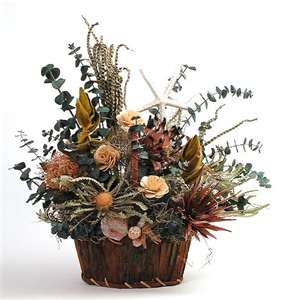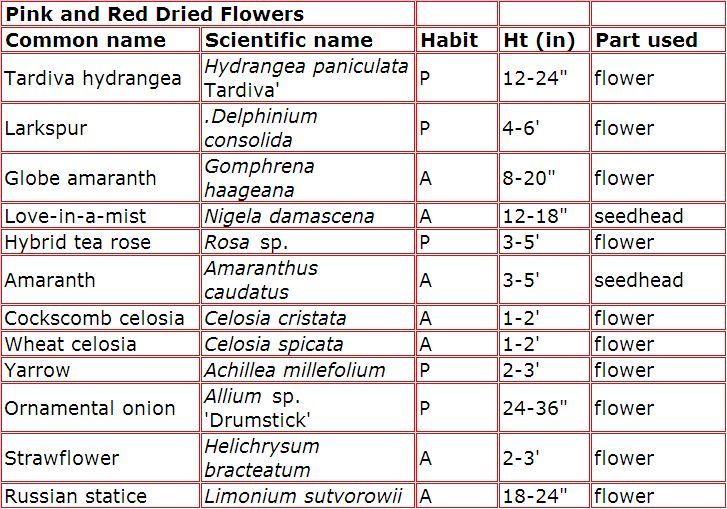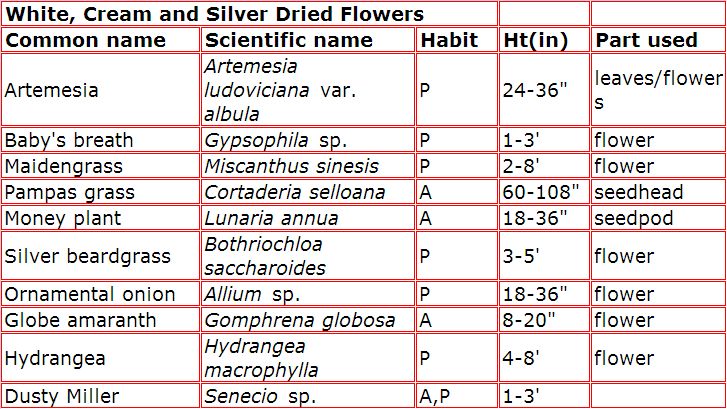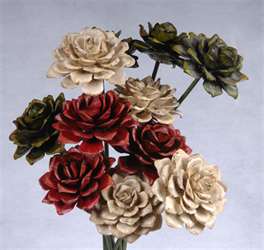

Everlastings (Dried Flowers)
While cut fresh flowers symbolize beauty and fleeting life, everlastings represent longevity and immortality. Everlastings are plants that retain their shape and color long after they have been picked and dried. Everlastings serve as a reminder of nature’s bounty and provide the home gardener with an opportunity to preserve the beauty of the growing season year-round.
In Victorian times, flowers and leaves that retained their fragrance were used to perfume and adorn homes. Rose petals and sweet-scented rushes were scattered on floors, while cloth bags and filigree containers filled with aromatic leaves and flowers freshened drawers and cupboards.
Today, interest in dried flowers is enjoying a resurgence in popularity. Dried plant materials provide an attractive option for urban dwellers who may have llttle time, interest or space to grow a garden. Many commercial nurseries all over the world are growing flowers solely for drying.
The Everlasting Garden
Although good plants for drying are available in the wild and from florists and suppliers, you may want to grow your own. A garden of everlastings starts with careful planning. Since flowers and plant materials for drying should be picked as close as possible to their prime, your planting plan should take into account such information as the height and width of the mature plant, flower and foliage color as well as the time of bloom.
The beds in your garden need to have a mixture of plants that will not be affected appreciably by the removal of flowers and foliage for drying. Mixed borders that contain herbaceous perennials, as well as shrubs, roses and annuals, are especially well-suited to the dried-flower enthusiast Not only do mixed borders provide a good selection of plants for drying, they also remain interesting over long periods of time.
A cutting and drying garden may be laid out in rows of plants similar to a vegetable garden. Lavender, celosia, gomphrena, strawflower and larkspur are good plant selections for the dryer’s garden. If desired, the rows can be arranged in compartments like rooms in a house and emphasize various themes, atmospheres and color schemes.
Materials for drying may also come from existing gardens or plantings in the home landscape. Even the vegetable garden provides good materials for drying such as okra pods, onion seedheads, asparagus leaves and some herbs. Many plant materials can be collected in the fall and winter and used directly in arrangements after gathering. These materials include cones, seed pods, grasses, berries and grains found in the garden as well as in fields and along roadsides.
Plant material may also be gathered in the wild. When gathering in the wild, there are a few common-sense rules to remember. Always leave enough plants in the wild to insure the success of the next generation. Second, be respectful of private property and protected areas. Third, do not harvest threatened or endangered plants. Lists of these plants are readily available from State Departments of Conservation or other conservation agencies. You may want to purchase a good field guide to assist you with identification.
Harvesting and Air Drying
Plant material for drying may be collected at any time during the year. Collect plant material on a day when the humidity is low. The late afternoon is preferable, after the heat of the day has passed and before the evening damp has set in. Cut the stem cleanly with pruning shears, scissors or a sharp knife; never pull a plant out by the roots. Prepare plant material for drying immediately after picking to prevent mold and discoloration. The easiest, most effective way to dry plants is by air drying. Since flowers will continue to open as they dry, select flowers that are not fully open. To preserve the best color and shape, remove the foliage from the stem and group together in small bunches secured with a rubber band or string.
Use of Drying Agents
Flowers may be dried in their natural form by totally burying the flowers in one of several desiccating materials. Desiccants are drying agents used to absorb moisture from flowers and leaves. Borax, sand and silica gel are desiccants that may be purchased at craft stores or through mail order. Flowers suitable for drying in desiccants include chrysanthemums, roses, peonies, larkspurs and daisies.
A popular mix for drying flowers is made of equal parts sand and borax. Choose sand that is fine, clean and dry. White cornmeal may be substituted for sand as it is light in weight and has less of a tendency to flatten flowers. The addition of three tablespoons of uniodized salt per quart of mix will help the petals retain their color.
Pour one to two inches of the borax mixture into the bottom of a low cardboard box. Position the flower in the mixture so that the petals are in a natural position. Slowly pour more of the borax mixture in the box until the plant material is completely covered. Place the uncovered box in a warm, dry place to allow for maximum aeration and evaporation. Flowers will dry in approximately three to five weeks.
Silica gel is available under a variety of trade names. It is white but some types contain blue crystals that act as an indicator of the amount of moisture which has been absorbed. As the moisture is absorbed from the flowers, the indicator crystals turn pink. To reuse silica gel, spread the gel on open cookie sheets and bake in the oven at 250 degrees until the crystals are blue again. This process should take approximately one hour. Store unused silica gel in air-tight containers.
Silica gel is generally applied the same way as the sand/borax mixture. There are a few important differences to remember. First, use shallow, air-tight containers to make the maximum use of drying material. Containers must be tightly sealed. If containers are not tightly sealed, the silica gel tends to absorb moisture from the air, and flowers dry too slowly or not at all.
Second, remove the natural stem and attach the flower to a short wire before placing in silica gel. Two techniques for wiring may be used: hook wiring and cross wiring. Hook wiring may be used for flowers with soft centers. Flowers with a harder base or center, such as roses, should be cross wired.
To hook wire a flower, use about a 20- to 24- gauge wire and push it upward through the center of the flower base. Bend a small hook in the end of the wire and pull it back through the flower. Make sure that the small hook is well hidden in the flower’s center as it will become visible as the flower dries.
.jpg?timestamp=1331618339267)
.jpg?timestamp=1331618379910)
To cross wire a flower, push the wire through the center of the flower base at right angles to the stem. The wire is centered in the flower base and both ends are then bent down and twisted together to make a short base. Flowers with wired stems are dried facing upward with the wire stem bent or curled along the bottom of the container. Flowers dried with their natural stems may be dried on their sides or upside down with their stems protruding upward. However, it is difficult to work the drying agent between the petals when flowers are placed facing downward.
Completely bury flowers in silica gel by gently sifting material over the petals. After all of the flowers have been added and covered, lift the container and tap it gently on the base to help settle the material. Cover tightly and prepare for storage. Flowers buried in silica gel dry very quickly - usually in five to ten days. Experimentation may be necessary as the exact drying time will vary with the thickness of the flower.
To remove flowers from drying agents, pour off drying mixture until the petals become visible. Gently lift flowers out of mixture. Turn flowers upside down and carefully tap out any remaining residue. If traces of drying agents remain, remove by brushing with a soft, dry artist’s brush or gentle stream of air.
Microwaving
Microwave drying only takes a few minutes and provides flowers that look fresher than those obtained by other drying methods. Begin by placing plant material in heat-tolerant glass or microwave container. Do not cover the container. To maintain shape, support material such as silica gel must surround the plant material throughout the drying process. A cup of water may be placed inside the microwave to prevent excessive drying.
Since microwave ovens and flowers vary, some experimentation may be required. Generally, drying time will vary from about three minutes for very dense flowers to about one minute for smaller flowers.
After microwaving, leave flowers in the silica gel for 12 to 24 hours to assure they are cooled and dry. Since microwave dried flowers tend to absorb moisture, you may wish to spray the petals with hair spray or lacquer to seal them.
Decorating with Dried Flowers
The exciting process of growing and drying flowers are merely preliminaries to the creative art of arranging them. Dried plant material offers a wide range of shapes, colors and textures for creating beautiful floral decorations. Some popular decorative uses include dried flower arrangements, hanging bunches, garlands, swags and wreaths.
Dried flower arrangements are particularly well-suited to office areas and lobbies where fresh cut flowers are too expensive and difficult to maintain. While choice and size of the container play an important role in determining the shape and style of your arrangement; nature is perhaps the best guide when creating arrangements of dried flowers.
Both drying and dried flowers look marvelous hanging in bunches against a wall, from ceilings or beams, or hanging from racks. Dried flowers should be bunched together according to color, shape and textural concerns. Ribbons or bows may be added to the bunches for a more decorative look.
Doorways, banisters, fireplaces and long tables covered with linen cloth take on a festive look when decorated with garlands and swags. A swag or garland is a rope of dried plant material designed to loop
from one point to another. The preparation of garlands and swags can be somewhat time-consuming; they are usually reserved for special occasions such as a wedding or holidays.
One of the most popular uses of dried materials is in the creation of wreaths. While there are a wide variety of store-bought bases that you can choose from such as wire, straw, grapevine and foam; you may choose to make your own from materials found in nature. There are many good books available to get you started on the creation of a dried flower wreath.
Storing Dried Materials
Drying method is the most important consideration when storing dried plant material. Flowers hanging in bunches to air dry can simply be left hanging, so long as they are hanging out of direct sunlight. Dried flowers that have been preserved in silica gel should be stored in air-tight containers for protection against humidity and to retain floral shape and color.
Materials that have been air dried or dried in borax mixtures may be wrapped in newspaper or tissue and stored in large, long cardboard boxes for protection against invading insects, dust and strong light. However, be certain that plant material is completely dry before storing, as any remaining moisture will cause the contents of the entire box to rot.
Dried plant material may last for several months without deteriorating when stored properly in a clean, dry place. However, even the best dried flowers eventually fade and should be discarded when they no longer produce the desired effect.








